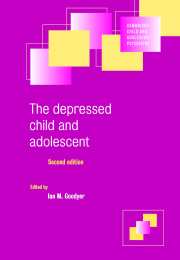Book contents
- Frontmatter
- Contents
- List of contributors
- Preface
- 1 Historical aspects of mood and its disorders in young people
- 2 The development of emotional intelligence
- 3 Developmental precursors of depression: the child and the social environment
- 4 Physiological processes and the development of childhood and adolescent depression
- 5 Childhood depression: clinical phenomenology and classification
- 6 The epidemiology of depression in children and adolescents
- 7 Family–genetic aspects of juvenile affective disorders
- 8 Life events: their nature and effects
- 9 Adolescent depression: neuroendocrine aspects
- 10 Suicidal behaviour in adolescents
- 11 Psychopharmacology of depressive states in childhood and adolescence
- 12 The psychotherapeutic management of major depressive and dysthymic disorders in childhood and adolescence: issues and prospects
- 13 Natural history of mood disorders in children and adolescents
- Index
13 - Natural history of mood disorders in children and adolescents
Published online by Cambridge University Press: 18 December 2009
- Frontmatter
- Contents
- List of contributors
- Preface
- 1 Historical aspects of mood and its disorders in young people
- 2 The development of emotional intelligence
- 3 Developmental precursors of depression: the child and the social environment
- 4 Physiological processes and the development of childhood and adolescent depression
- 5 Childhood depression: clinical phenomenology and classification
- 6 The epidemiology of depression in children and adolescents
- 7 Family–genetic aspects of juvenile affective disorders
- 8 Life events: their nature and effects
- 9 Adolescent depression: neuroendocrine aspects
- 10 Suicidal behaviour in adolescents
- 11 Psychopharmacology of depressive states in childhood and adolescence
- 12 The psychotherapeutic management of major depressive and dysthymic disorders in childhood and adolescence: issues and prospects
- 13 Natural history of mood disorders in children and adolescents
- Index
Summary
Knowledge of the natural history of an illness is critical to understanding its origins and to optimizing its management. Over the past 15 years or so, data have been accumulating steadily on the course and outcome of juvenile affective conditions. The main purpose of the present chapter is to review these studies. The chapter is divided into five parts. The first part is concerned with the risk of recurrence of juvenile depression and the second part with the mechanisms that might be involved. The third part describes the prospects for recovery. The fourth part reviews the natural history of other juvenile affective disorders, principally bipolar disorder. The chapter concludes with a discussion of some of the clinical implications of these research findings.
Continuity and recurrence of depression
Continuities in the short term
Many studies of clinical samples have reported that young people with a depressive disorder have a high risk of recurrence or persistence (King & Pittman, 1970; Kovacs et al., 1984a; Asarnow et al., 1988; Goodyer et al., 1991; McCauley et al., 1993; Emslie et al., 1997b). For example, Kovacs and colleagues (1984a) undertook a systematic follow-up of child patients with a major depressive disorder, a dysthymic disorder, an adjustment disorder with depressed mood, and some other psychiatric disorder. The development of subsequent episodes of depression was virtually confined to children with major depressive disorders and dysthymic disorders. Thus, within the first year at risk, 26% of children who had recovered from major depression had had another episode; by 2 years this figure had risen to 40%; and by 5 years the affected cohort ran a 72% risk of another episode.
Keywords
- Type
- Chapter
- Information
- The Depressed Child and Adolescent , pp. 353 - 381Publisher: Cambridge University PressPrint publication year: 2001
- 14
- Cited by



